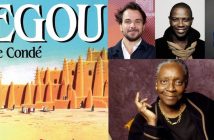« The goat has its ideas but so does the hen ». The Malian peasant who says this is at the witness stand of a court set up in a courtyard in a popular neighborhood of Bamako, for a trial which opposes civil society and globalization’s international institutions, the IMF and the World Bank first and foremost. During these lively debates broadcast through an outside loudspeaker, life goes on in the courtyard: women dye batiks, a couple is wed while another separates, children come and go. It’s in his recently deceased father’s courtyard that Abderrahmane Sissako wanted to shoot because it was here, in this place full of life, that he grew up and passionately discussed Africa with him.
Unlikely construction? Of course, but so relevant that it becomes convincing. Too intellectual a debate? How can one think that ordinary people can’t understand what is brewing? Manthia Diawara had already shown it in his documentary Bamako Sigi-kan (The Pact of Bamako): ordinary people are not dupe; their conscience is acute, their reflection upon the world permanent. They perfectly understand the words and issues of this trial because they experience them daily in their flesh. And even if the ideas expressed are already known to everyone, saying them again, transcending them with the strength of an artistic expression, was necessary. The deep emotion that one feels when one agrees to open up to this film goes far beyond the discourses trotted out on the failings of globalization and North/South relations. Probably because faced with complexity, going back to simple ideas is essential as it is for these to be even more anchored through sensitivity.
As there had to be argumentation and debating, a trial with lawyers and witnesses was a prerequisite, just like in American cinema! As it is urgent to concentrate on strong ideas to counter both the failure of the appeals to common sense and identity politics, the defence pleas had their place, with the fervour and commitment of its rhetoric. It is this court we attend that the duplicity of the G8 nations is exposed; the G8 nations who claim their good will by debt cancellations widely covered by the media when, even though already amply reimbursed, it continues to bleed dry the countries caught in a noose, which prevents them from providing social services. « The noose » is the title of a book by Aminata Traoré – ex-Minister of Culture in Mali- who is called to the witness stand here. Condemning the cynicism and dishonesty of the rich countries, this trial accuses the rape of the imagination as much as the destruction of the public services orchestrated by the cultural adjustements plans which only led to failure. The opportunity to speak out is given to the orators such as like Aminata Traoré or a brilliant teacher but also and foremost to common people. The summum of expression and emotion is reached when a peasant, Zegué Bamba, is no longer able ton contain what he wants to say and, twirling his flyswatter, launches into a long half-spoken/half-sung lament. We listen to him all the more since his words are not translated in subtitles, therefore escaping all exotic projection and reduction. Heartrending and deeply dignified, his cry echoes an Africa that suffers but never yields.
Shot on video with static shots which intensify the ceremonial, the trial calls on real judges and lawyers who were free to develop their own arguments. They are all the more sincere and convincing. They were left time to demonstrate and their image isn’t fragmented by the multiplication of shots, which allows them to be credible. From time to time, image shots on film come to enrich rather than illustrate the discourse. Those of the migrants turned back into the desert are not a copy/paste of the story of the one at the witness stand: in a few shots that rally more than they are overpowering, Sissako summarizes the scandalous inhumanity with which emigration is dealt. Here, words are redundant: as Oumou Sangare’s beautiful melancolic singing echoes, the women’s dye gives off reddish water and the cloth obtained invades the screen.
In the middle of the film, although there are black and white lawyers in both camps, a hilarious sphagetti western episode featuring both actor Dany Glover and film-makers Elia Souleiman and Zeka Laplaine brings to mind, by its mimetic construction and use of burlesque, The Return of the Adventurer by Moustapha Alassane, but also stands out as an illustration of the international institutions’ interventions. It is indeed Black people who get rid of « the teacher who’s in the way »: far from the discourse of a victim, Sissako recalls the Africans’ participation in their continent’s suicide.
But the North cannot be reprieved. Its responsibility is inescapable, as it stigmatizes Africa today for problems it itself has provoked, casually confusing causes and consequences, pauperization and poverty. The civil society lawyers expose this hypocritical ballet that keeps the vision of a cursed Continent doomed to misfortune and corruption alive. There will be more tears, like those of Aïssa Maïga who sings so well. Utopia alone is all that remains to avert them, this African ram which quite literally butts Master Rappaport, the international institutions’ lawyer. And this utopia would be to, by hook or by crook, put these institutions back at the service, not of liberal capitalism, but of men, their original vocation.
It is luminous, like this superbly lunar film in which women are the main driving force, in which each image has its own beauty and stratum of meaning. Beyond the acute conscience of Africa’s tragedy, a solitary body that only a dog dares to sniff, a big breath of fresh air is possible, if the fans are set in the right place. If only it were done: it is to this utopia that this beautiful film calls out; a film that beautifully and profoundly marks everyone.








